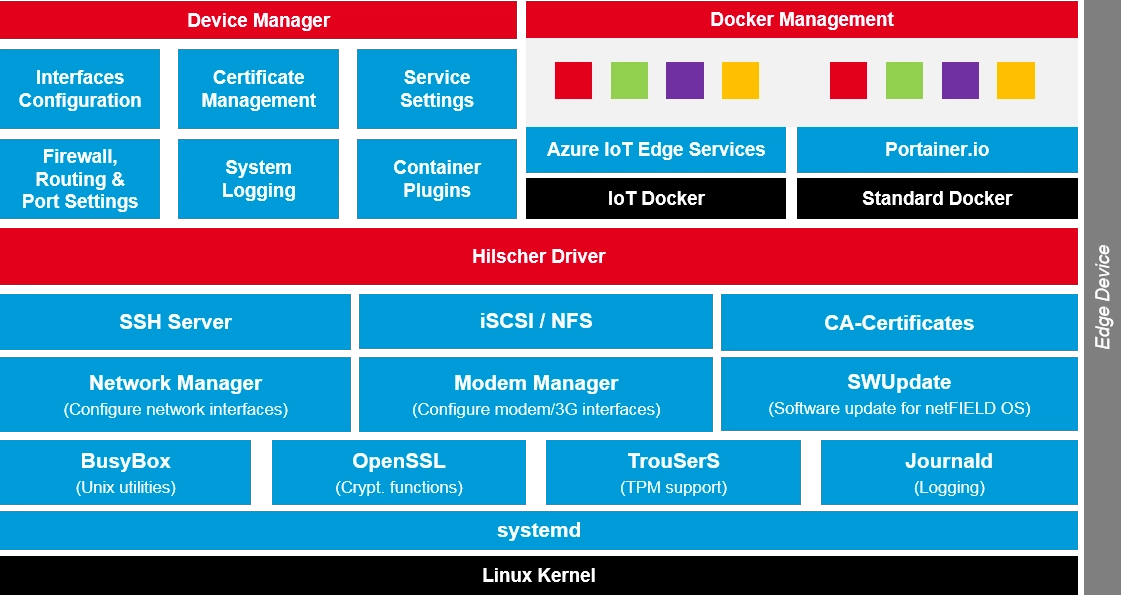Run Docker containers
Secure operating system for an intelligent edge.
Industrial IoT Operating System
The netFIELD OS, as a part of our technology portfolio, supports scalable field device hardware depending on the customer's use case. In order to achieve this, applications do not run directly on the host system but instead as containers in a Docker runtime. Our OS is very lean and only supports the essential services required by the customer's network infrastructure.
Features
Run containers
Containers are revolutionizing connected IoT devices, and netFIELD OS is the perfect match to run them.Manage device
Manage your device locally with a web-based interface. It’s easy to administer storage, configure networks, and more.Build to last
Build to survive in harsh environments like unexpected shutdowns with security in mind.Easy to port
Based on Yocto Linux for easy porting to most capable device types across various CPU architectures.Architecture
Hilscher netFIELD OS is a secure operating system that makes it easy to program, deploy, connect and manage edge devices. Hilscher netFIELD OS extends the Linux kernel, with software libraries to securely connect operation technology like PLC, MES, Historians, Files or other on-premise systems with IT services like the netFIELD Portal. Our OS lets you innovate faster embracing container technologies managed by the netFIELD Portal from a central point or locally at the edge.
Core Services
The netFIELD OS core services include the support of hardware interfaces, the network environment, secure communication and system logging. In order to support the customer in setting up the gateway configuration, the Device Manager is coming along with the core services. With the open plug-in mechanism, the functionality of the Device Manager can be easily extended with the help of containerized applications.
Container Management
Application containers can run in the IoT Docker or Standard Docker environment and do contain business logic such as for data acquisition, analytics, processing or connectivity to cloud or enterprise systems.
The container management provides the functionality to pull and run containers on the device itself. Before a container can be run its image needs to be pulled from a certain container registry. After that the container is created, the application can be then controlled by using the start / stop commands or by enabling the autostart option. Also, the deletion of containers and images is a part of container management. In order to enable the field devices for off- and online scenarios, netFIELD OS provides two Docker runtime environments at the same time.
The IoT Docker environment is managed by the netFIELD.io platform remotely. Thats why there is no need to have direct access to the netFIELD Device, as long as the device can hold his connection to netFIELD.io. Administrators can be anywhere and have full management access to the device with the stored images and has the ability to control the application containers remotely. Otherwise the Standard Docker can be used locally, if the netFIELD device is not connected to netFIELD.io. In this case the Standard Docker runtime environment can be managed by the netFIELD OS command line interface or by a web application like portainer.io, which is running in a container as well.
The Standard Docker can be used locally, if the netFIELD device is not connected to netFIELD.io. In this case the Standard Docker runtime environment can be managed by the netFIELD OS command line interface or by a web application like portainer.io, which is running in a container as well.
Inter-Container Communication
Application containers usually focus on the dedicated business logic in order to avoid the development of unmaintainable software monoliths. In this scenario, multiple containers need to work together to realize customer use cases. Our powerful message and container oriented architecture provide the highest level of flexibility and reusability when implementing customer solutions with individual requirements. This reduces IoT solution cost in development and operation.
